New Chromatography Columns and Accessoies at Pittcon 2007: Part II
LCGC North America
This month's installment of "Column Watch" is the conclusion of a two-part series in which columnist Ron Majors examines trends in column and sample prep introductions at Pittcon 2007.
Pittcon 2007 — the 58th Pittsburgh Conference on Analytical Chemistry and Applied Spectroscopy — returned to the massive McCormick Place in Chicago, Illinois, on February 25–March 2, 2007. This year's event hosted more than 1000 instrument manufacturers and 1aboratory suppliers in more than 2500 booths. In addition to attending the exposition, the conferees listened to 1250 oral presentations, viewed more than 975 posters, checked numerous company seminar rooms, or attended one of 110 short courses.
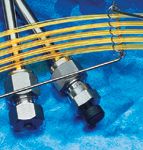
Undoubtedly, Pittcon still remains the most important yearly international analytical exhibition where companies introduce their latest instruments, instrument accessories, columns, sample preparation products, and other consumable products. Because many past attendees have purchased one or more new products within three months after attending the show, most exhibitors attempt to maximize their booth traffic to meet as many potential customers as possible.

Ronald E. Majors
The purpose of this report is to provide information about many of the new separation consumables and accessory products that were displayed at Pittcon 2007. In some cases, products that were introduced during 2006 but after Pittcon 2006 (1,2) might be included for reasons of completeness. The information is based upon manufacturers' responses to a questionnaire mailed in December 2006. Because of space limitations and the fact that some manufacturers did not respond to the questionnaire, this report cannot be considered an exhaustive listing of all new products that were introduced in Chicago. However, over the years, these Pittcon summaries have provided a good source of information that would be difficult for one individual to gather during the four days of the exhibition. In addition, the products introduced have shown definite correlations to current research, development, and application activity in the separation sciences.
As in previous years, columns and other products recommended by their manufacturers primarily for biomolecule separations or sample preparation are denoted in the tables with the designation BIO. Some of these products can be used for general high performance liquid chromatography (HPLC) separations as well, but their main emphasis is for biological samples. I will cite specific information about bioapplications where appropriate. Because the sub-2-μm HPLC columns are still quite new and require special care in their use, I have classified them as specialty columns or in a new series if an entire family was introduced at Pittcon.
In last month's coverage, I described new introductions in the areas of high performance liquid, reversed-phase, normal- and bonded-phase, ion-exchange and ion, size-exclusion (SEC), large- and preparative-scale, and specialty chromatography columns. In this month's coverage, I will look at gas chromatography (GC) products, sample preparation products, and hardware, accessories and kits for chromatography and sample preparation.
Trends and Highlights
General: This year, I observed that there was a continued trend in high throughput techniques especially in the HPLC and sample preparation areas. In HPLC, there was an increase in the number of short and long, sub-2-μm columns and ultrahigh pressure products while in sample preparation there were many products for solid-phase extraction (SPE) automation. Still, a large number of products will be introduced for the separation, sample preparation and for LC–mass spectrometry (MS) measurement of proteins, still the hottest area in chromatographic research and applications. Many application-specific columns for HPLC and GC were noted. A considerable number of new accessories in the HPLC/ion chromatography area were noted.
HPLC columns: Reversed-phase HPLC maintains its dominance and a significant number of regular reversed-phase and specialty reversed-phase columns were introduced. Particles are getting smaller (down to 1.5 μm), some with new designs and columns are getting shorter; these columns allow separation speeds unheard of a decade ago. With the advent of new higher-pressure instrumentation, new columns, column hardware and fittings and more rugged column packings are being introduced. Specialty columns for proteins and peptides comprised about half of the specialty column offerings. Columns for the direct injection of drugs in biological fluids, more high efficiency polymeric columns, and packings with reduced tailing for basic compounds were among the highlights at this year's Pittcon.
Gas chromatography: GC columns this year were highlighted with higher temperature limits, lower bleed and specialty columns for pharmaceutical, food/beverage and flavor/fragrance analysis. A porous-layer open tubular (PLOT) column for oxygenate analysis, such as methyl-tert-butyl ether (MTBE), in gasoline was introduced. Supercritical fluid chromatography (SFC) is getting more attention, especially in the preparative mode, and new packed columns for SFC were brought to market.
Sample preparation: Products for the preparation of tiny amounts of samples in the microliter and submicroliter range were quite prevalent. With a continuing trend, polymeric SPE phases represented about half of the products seen this year. Formats ranged from 96-well plates for method development, protein precipitation and immobilized liquid extraction to SPE pipette tips to disks and cartridges to a new "in-syringe" SPE technique. More molecular-imprinted polymer (MIP) SPE products were to be introduced. Products for the depletion of high abundance proteins and phosphorylated peptides from serum, selective phases for environmental contaminants, a special chiral product for rapid enantiomeric separation and phases for the direct injection of biological fluids were noted. Two manufacturers introduced a new technique called dispersive SPE.
Accessories: A total of 30 new accessories for LC–ion chromatography, GC, and sample preparation were noted. A large number of HPLC accessories were introduced, such as fittings, in-line filters, small internal diameter tubing, injection valves, many suited for the newer high efficiency and high-pressure columns on the market. Ion chromatography saw new suppressor designs and a carbon dioxide removal system. Software for peak tracking, column comparison and e-learning were introduced. GC accessories included gas traps, gas generators and preventive maintenance kits. A number of workstations for solid-phase extraction, evaporation–concentration, liquid-phase sample preparation, and solvent recovery were introduced.
GC and SFC Columns
Although GC is considered to be a relatively mature separation technique, new GC/SFC columns continue to be introduced each year at Pittcon (Table I), 11 in all for this year. All GC columns were the wall-coated open tubular (WCOT) format with the exception of one PLOT column. With the popularity in SFC, especially in preparative applications in the pharmaceutical industry, new packed columns were introduced to meet these new applications. The SFC columns are more similar to HPLC columns than GC columns both in phases and in dimensions. ES Industries (West Berlin, New Jersey) introduced two product lines based on unique chemistries for specific compound classes.
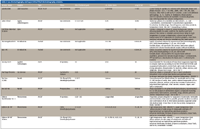
Table I: Gas chromatography and supercritical fliud chromatography columns.
In recent years, there has been a GC trend in the introduction of ultralow-bleed WCOT stationary phases that allowed better detection limits, less baseline drift during temperature programmed separations, and improved compatibility with GC–MS analyses. This year almost every GC column had lower than "normal" bleed specifications.
All of the general-purpose GC capillary columns displayed at Pittcon 2007 were crosslinked phases. Crosslinked, chemically bonded, or immobilized phases are more stable, have lower bleed, and usually operate at higher temperatures than coated phases. Another advantage of the bonded phases is their ability to be solvent-rinsed. If a column becomes contaminated by high boilers, inorganic compounds, and other nonvolatile impurities that may cause drifting baselines, bleed and other undesirable occurrences, it can be disconnected, washed (outlet to inlet direction) with various solvents and placed back into the gas chromatograph for further use. Capillary columns with internal diameters ranging from 0.18 mm (small bore) to 0.53 mm (large bore or megabore) were the most popular sizes.
High-temperature GC applications are always in demand for the analysis of high boiling petroleum fractions. Simulated distillation is used in the petroleum industry to characterize high boilers in distillates. Phenomenex (Torrance, California) has responded with two high-temperature columns that can withstand temperatures as high as 400 °C isothermal or up to 425 °C for short-term temperature programming. Compared with other ultrahigh-temperature columns that are constructed of metallic materials, these columns are constructed from nonmetallic tubing.
When baking out the GC flow path to rid of high boiling contaminants, one should not take the installed column above its upper temperature limit. Spex CertiPrep (Metuchen, New Jersey) has introduced a temporary column that can be substituted for the installed column during a high-temperature bake-out.
Applications-specific columns are always popular introductions at the Exposition. Columns for volatile enantiomers were introduced by Astec, acquired by Supelco (Bellefonte, Pennsylvania) in late 2006, and GL Sciences (Torrance, California). The latter column is based on a mixture of cyclodextrins that provides a more universal chiral column than having a specific cyclodextrins. The Zebron MultiResidue orthogonal capillary columns are specifically designed for pesticides and herbicides and provide confirmation based on relative retention times of the same compounds on the two columns.
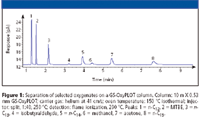
Figure 1
Fuel oxygenates are chemicals containing oxygen that are added to fuels, especially gasoline, to make them burn more efficiently. Adding oxygenates, such as MTBE, to gasoline and diesel fuel boosts their octane level and reduces atmospheric pollution associated with automobile emissions, especially carbon monoxide emissions. Oxygenates, such as methanol, are added to crude oil to prevent formation of hydrates (for example, solid water–hydrocarbon structure) but too high a level of oxygenate can poison catalysts during the refining process. Thus, the analysis of MTBE and other oxygenates in crude oil, diesel, and gasoline has become very important. The Agilent (Wilmington, Delaware) GS-OXYPLOT column is a specialty PLOT column for oxygenate analysis in the petrochemical industry according to several of the American Society for Testing Materials (ASTM) methods (see Table I). This column has been optimized for this analysis and can be "dropped-in" with current oxygenate methods. Figure 1 shows an example of the types of samples that might be encountered when investigating oxygenate contamination. This column is often used in conjunction with a boiling point separation column (like 100% polydimethylsiloxane) to backflush high boilers to prevent interference.

Table II: Sample preparation products.
Sample Preparation Products
As indicated in Table II, Pittcon 2007 was another productive year with 25 new sample preparation products or families of products displayed. Not counted were sample preparation accessories (Table III), which will be covered later. Among the more popular introductions were products to deal with increasingly smaller amounts of available sample. Cartridges, disks, pipette tips, well plates, and spin tubes were among the formats introduced. Just about every mode of SPE (reversed phase, ion exchange, normal phase, complexation, affinity, mixed mode, molecular imprinting, shape selectivity) was displayed. An interesting in-syringe micro SPE device was introduced by SGE (Austin, Texas).

Table III: Chromatographty and sample preparation accessories.
In the last several years, the 96-well plate design for SPE, protein precipitation, and filtration has proliferated driven by the needs of high throughput sample preparation automation requirements. Compared with last year (2), this year numerous sample preparaton plate products were again in evidence. Most of them were SPE plates or variations of SPE-plates. For example, ILE's (formerly Wohleb Scientific) (Ferndale, California) well plate is used for immobilized liquid extraction where a polymeric phase is immobilized onto the sides and bottom of a 96-well plate and used for liquid–liquid extraction. Figure 2 depicts the experimental procedure to perform an extraction in the well. In-soluble polymeric phases that include GC-like phases such as 100% polydimethylsiloxane and trifluropropylsiloxane act as an extracting liquid. Liquid handling systems dispense and aspirate solvents during the extraction process. Supelco's and Phenomenex's SPE Method Development plates consisted of multiple rows of different SPE phases, and using automated xyz liquid handling systems, a number of phases can be automatically screened for the optimum final choice.
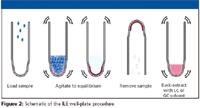
Figure 2
Other variations of SPE plates were those of Varian (Palo Alto, California) whose 96-well plate has a mixed-mode phase that can be used for the analysis of drugs in biological fluids by direct injection. The outer portion of mixed mode phase excludes proteins while small drug molecules are retained by the inner hydrophobic portion of phase. The structure of and operational procedure for the use of Bond Elut Plexa SPE polymeric media is shown in Figure 3. The company supplies two different optimized extraction protocols: one for the extraction of acidic compounds and one for the separations of neutrals and basic compounds.
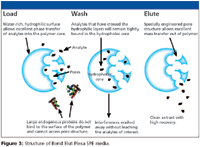
Figure 3
Precipitation plates are a popular alternative to SPE plates for drugs in biological fluids. Rather than trying to separate the proteineous material, by the addition of acetonitrile to diluted plasma, proteins are precipitated as a bead and the supernatant is filtered and analyzed by LC–MS. Such a simple procedure minimizes development time but the protein-depleted biofluid still contains other biological compounds that may interfere with subsequent LC detection. The specificity of MS helps to determine the specific drug to be analyzed. Several companies introduced their version of a protein precipitation plate.
Another popular area for product introduction was high abundance protein depletion products, mainly for human serum proteomic studies (3). The high-abundance proteins, human serum albumin and immunoglobulins, constitute as much as 75% of the protein content of human plasma and often mask small concentration protein biomarkers in gel electrophoresis or HPLC studies. Immunoaffinity techniques are quite popular here due to their specificity. Several products are now on the market (4) including two new spin columns introduced at Pittcon 2007.
Specialized SPE application chemistries were also introduced. Polymeric packings can be used under a wide variety of experimental conditions especially at extreme pH values. Polymeric SPE products were displayed by Varian, Agela Technologies (Newark, Delaware), Grace Davison Discovery Sciences (Deerfield, Illinois), Supelco/Sigma Aldrich. MIPs are quite popular in Europe, less so in the United States. These phases are very selective due to the presence of molecular imprints of a specific template on the surface of a polymer. MIPs are prepared by adding a target template molecule to the monomer reaction mixture and forming a polymer around the template. The template is extracted away leaving behind its imprint on the surface. When a mixture of compounds containing the target molecule is introduced to the MIP, usually packed into a column or cartridge, there is a stronger affinity for the target molecule by the imprinted site. This is viewed by some as a "lock-and-key" mechanism. So the process very much resembles affinity attraction. Usually MIPs are customed synthesized but MIP Technologies (Lund, Sweden) has uncovered some high volume applications and have developed off-the-shelf MIPs for specific pharmaceutical compounds. In addition, they launched an MIP screening service consisting of over 50 sorbents.
More traditional markets are also addressed. Environmental and food samples often contain low concentrations of contaminants that have to be analyzed and enrichment is often required. SPE is a technique often used for this purpose. For example, Supelco immobilized silver ions on a cation exchanger that is selective for cis-trans fatty acid methyl esters, often found in food products. United Chemical Technologies (UCT, Bristol, Pennsylvania) has introduced specific SPE cartridges for the isolation of polynuclear aromatic hydrocarbons, nitrosamines, and polar and nonpolar organic compounds from drinking water.
One of the more interesting new sample preparation techniques has an interesting name coined QuEChERS SPE (4–6). These letters are short for Quick, Easy, Cheap, Effective, Rugged and Safe SPE. Introduced as products by UCT as QuEChERS SPE and by Supelco as dispersive SPE (dSPE), this method is an emerging sample preparation technique that is becoming increasingly popular in the area of multiresidue pesticide analysis in food and agricultural products. In dSPE, food–agricultural samples are first extracted with an aqueous miscible solvent (for example, acetonitrile) in the presence of high amounts of salts (for example, sodium chloride and magnesium sulfate) and buffering agents (for example, citrate) to induce liquid-phase separation and stabilize acid- and base-labile pesticides, respectively. Upon shaking and centrifugation, an aliquot of the organic phase is subjected to further clean up using SPE. Unlike traditional methods using SPE tubes, dSPE clean up is conducted by mixing bulk amounts of SPE sorbent with the extract. After sample clean up, the mixture is centrifuged and the resulting supernatant can either be analyzed directly or can be subjected to minor further treatment before analysis. Both commercial products consist of centrifuge tubes containing predetermined amounts of salts and SPE sorbents to support the most common method configurations used today. The QuEChERS SPE approach is on the verge of becoming an official European EN method.

Companies Listed in This Column
Chromatography and Sample Preparation Accessories
Table III lists 30 new hardware products and accessories for HPLC, GC, CE, and sample preparation. This year I have extended the columns and sample preparation accessories to include dedicated instruments that are designated to automate some of the sample preparation techniques reported in Table II. All of the products introduced were practical devices designed to make the chromatographer's life easier. I will cover each area individually.
HPLC, LC–MS, and ion chromatography products: With the advent of short, high performance columns packed with small particles (less than 3.0 μm in diameter), new low-volume, higher pressure devices are needed. This year's Pittcon saw the introduction of 25-μm i.d. PEEK tubing for inert connecting–transfer lines, empty high-pressure columns (up to 1000 bar), direct-connect guard columns, nanovolume injection valves, in-line filters, and zero-dead-volume unions, mostly for low-dispersion instrument configurations. New software for e-learning, peak tracking, and column comparison was introduced. A new carbonate removal device lowers the background conductivity in suppressed buffer systems by taking out carbon dioxide from the eluent. Another innovation for ion chromatography was a self-generated suppressor system based on an improved membrane design that eliminates background signal due to the presence of ionic materials in the eluent. It can operate at a higher background pressure than previous suppressors.
GC–SFC products: A new nitrogen gas generator will help to eliminate gas cylinders in the laboratory and an in-line gas trap will make sure that oxygen, moisture and hydrocarbons will ensure its purity. A preventive maintenance kits will prevent problems before they arise and will call attention to potential problems so that GC users are better educated on problem sources. These and other products will help to make GC a troublefree analytical technique.
An automated dynamic headspace instrument will help to ensure GC inlets and columns remain uncontaminated while providing increased sensitivity for trace volatile organics.
Sample preparation products: Automation products were among the more numerous sample preparation products at Pittcon 2007. Products in this category were three solvent evaporation workstations: one for parallel vacuum evaporation, a second one for centrifugal evaporation, and the third to condense solvent vapors from a concentrator system. To obtain a more representative sample, a new freezer mill will help to pulverize those difficult samples. In addition, new SPE workstations, some of which also filter, will streamline sample preparation and improve throughput. These systems use both standard and non-standard cartridges. To address the need for protein fractionation a new automated system will isolate, desalt and concentrate proteins and place them on a slide suitable for matrix-assisted laser desorption ionization (MALDI)-MS analysis.
Acknowledgment
I would like to thank the manufacturers and distributors that kindly furnished the requested information in advance of Pittcon 2007, thus allowing a timely report on new product introductions. For those manufacturers who would like to be considered for inclusion into Pittcon 2008 coverage, please send the name of the primary company contact, the mailing address, FAX and E-mail numbers to Patrick Kempf, Editor, LCGC North America, c/o Advanstar Communications, 485 Rte. 1 South, Bldg. F, Iselin, NJ 08830, Attn.: Pittcon '08 "Column Watch".
Ronald E. Majors Ronald E. Majors "Column Watch" Editor Ronald E. Majors is business development manager, Consumables and Accessories Business Unit, Agilent Technologies, Wilmington, Delaware, and is a member of LCGC's editorial advisory board. Direct correspondence about this column to "Sample Prep Perspectives," LCGC, Woodbridge Corporate Plaza, 485 Route 1 South, Building F, First Floor, Iselin, NJ 08830, e-mail lcgcedit@lcgc-mag.com
References
(1) R.E. Majors, LCGC 24(3), 248–266 (2006).
(2) R.E. Majors, LCGC 24(4), 356–373 (2006).
(3) N. Zolotarjova, P. Mronzinski, and R.E. Majors, LCGC 24(2), 118–138 (2007).
(4) S.J. Lehotay, K. Mastovska, and A.R. Lightfield, J-AOAC-Int., 88(2) 615–629 (2005).
(5) S.J. Lehotay, Interlaboratory Validation of the QuEChERS Method to Analyze Pesticide Residues in Fruits and Vegetables, Proceedings AOAC Annual Meeting, St. Louis, Missouri (2004).
(6) M. Annastassiades, "QuEChERS – A Mini-Multiresidue Method for the Analysis of Pesticide Residues in Low-Fat Products," http://www.quechers.com/.

New Method Explored for the Detection of CECs in Crops Irrigated with Contaminated Water
April 30th 2025This new study presents a validated QuEChERS–LC-MS/MS method for detecting eight persistent, mobile, and toxic substances in escarole, tomatoes, and tomato leaves irrigated with contaminated water.
University of Tasmania Researchers Explore Haloacetic Acid Determiniation in Water with capLC–MS
April 29th 2025Haloacetic acid detection has become important when analyzing drinking and swimming pool water. University of Tasmania researchers have begun applying capillary liquid chromatography as a means of detecting these substances.
Prioritizing Non-Target Screening in LC–HRMS Environmental Sample Analysis
April 28th 2025When analyzing samples using liquid chromatography–high-resolution mass spectrometry, there are various ways the processes can be improved. Researchers created new methods for prioritizing these strategies.

.png&w=3840&q=75)

.png&w=3840&q=75)



.png&w=3840&q=75)



.png&w=3840&q=75)












